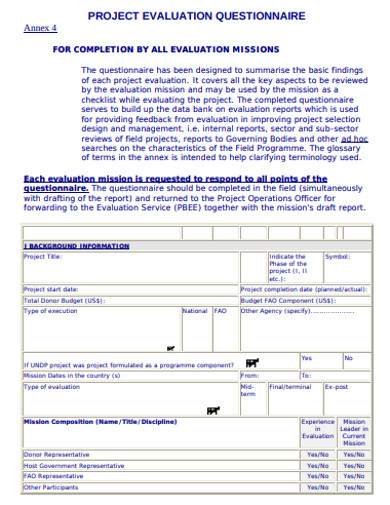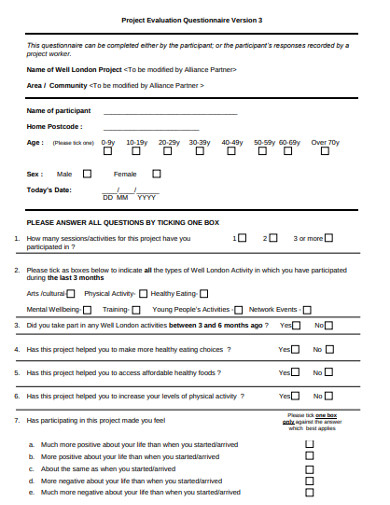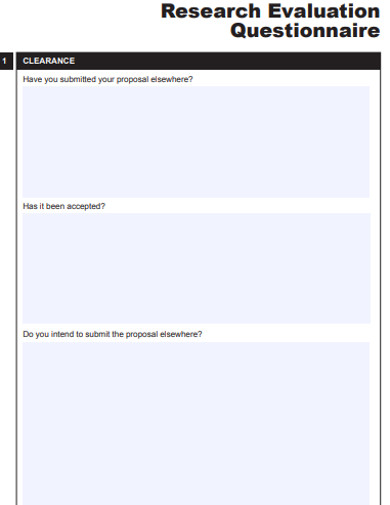Project Evaluation Questionnaire Examples
We view success through retrospective lenses. Despite exhaustive planning and preparation, we can’t guarantee a 100 percent success rate in our projects. We need to assess the activity to see if the project design, process, and output met our expectations. Project evaluation is a vital step in project management and important business decisions.
Effective project management involves measuring the success of a project based on its process, results, and impact. Therefore, a successful project is that which meets the goals and objectives set at the beginning of the endeavor. Project evaluation monitors the degree of project success against set short term and long term criteria. Project evaluation questionnaires are project management tools for this end. They are a checklist of assessment questions regarding the integrity and impact of the project.
Value Of Project Feedback
Any activity that requires an input of manpower and resources has to undergo evaluation. Evaluations are a learning process than answer the questions on the project’s productivity, the entire project design, and corrective measures. Because the company or organization already invested resources, there should be a fruitful return of the expense. How the team monitors the project should be decided before project proposal. This allows for continuous monitoring and learning from the start of the project. When the team keeps a close eye on the progress of the project, they can spot forewarning for any necessary intervention that may be required for the success of the project.
Launching a project requires funding. Consider the interest of the stakeholders of the company and of the project itself. By closely monitoring the project’s every step, we can steer the project towards more sustainable and long-term results. Other than tracking the activity’s development and the output’s impact, successful projects with resounding results are resume in itself for future investors. Records of the project from beginning to end show that we can make things happen. We can garner more support for future projects because of this.
Measures Of Success
The success of our project depends on our definition of success. To illustrate this point, we look at a case of definitions affecting success in an unemployment rate drop in the US. Investopedia states the working definition of unemployment as the number of people looking for a job but is still jobless. When the unemployment rate in the US fell to 3.9 percent, it was a cause for celebration. But before we start popping bottles of champagne for the country’s economic health, let’s be more critical about this statistic for a moment.
Remember that percentage is a dimensionless quantity that expresses a specific part of a whole. Therefore, the percentage of unemployment is the fraction of people looking for jobs out of the total number of employed and unemployed individuals.
According to a Forbes article, the unemployment rate goes down when we increase the number of employed people. However, a person is not technically a part of the unemployed group when he or she is no longer actively looking for a job. Thus, the number of unemployed people drops. And the latter was reflected in the 3.9 percent unemployment rate drop.
Definitions matter. The success of our project lies in how we measure its success. During our project planning stage, we should already institute clear cut criteria for what we consider as successful. Steer clear of motherhood statements like “This project will solve climate change.” Because unless we have the hard data and significant statistical results to back that statement, we shouldn’t claim that.
Aside from the actual result of the activity, we can use its relevance and consistency with the priorities of the company as a measure. The project design’s feasibility and alignment with the goals and objectives of the endeavor is another good criterion that we can evaluate. We should also look into how faithful the project team is to the designated roles, design, and project timeline. Don’t forget that the return of invested resources is a viable measure of success, also.
2+ Project Evaluation Questionnaire Examples & Templates
The following are sample project evaluation questionnaires that allow for effective monitoring of project feedback.
1. Sample Project Evaluation Questionnaire Example
2. Basic Project Evaluation Questionnaire Example
3. Project Research Evaluation Questionnaire Example
Evaluation Questionnaire Construction
Project evaluation questionnaires are important in the assessment of a project’s success. Therefore, the right questionnaire for the job is critical to perform the necessary appraisal. When you are making the document, it is wise to note that a good questionnaire:
1. Clearly Defines Success
As the evaluator, you should have a working knowledge of the project. This is settled if you are part of the team. But when you are an independent evaluator, meet with the project team and decide how you can assess the project in all known criteria for success. This is to align your vision and priorities with the team’s. Develop a standard and objective rubric on how you are going to rate the project’s progress and output. Define what makes a one a one and a 10 a 10. Then, outline the goals and objectives of the activity in a worksheet. For easy use, go for a tabular format for the rating sheet.
2. Examines Project Design
Because project evaluation shouldn’t just focus on the results but also on how the team got there, the project approaches and the justification behind them is an area open to scrutiny. The evaluator has to review the rationale and reasons for these decisions if they go back to the project’s goals and objectives. The evaluation questionnaire should contain questions like “Is the team’s strategy efficient in mobilizing the project plan?” and “Did the intervention and corrective measures make a significant contribution to the results?” The document should let you assess the decisions made from the project planning to execution.
3. Monitors Project Timeline
From start to finish, you have to keep tabs on the progress of the project. Thus, the evaluation questionnaire should cover these developments. It should include a section where you can compare the schedule with the actual project timeline. Through close observation of the activity’s development, you can also foresee if the project is right on schedule. Information from helps in deciding whether the project was just delayed due to hitches in the plan or if the timeline set was unrealistic for this type of venture. The team can also make adjustments to the plan given this information.
4. Allows Independent Review
In assessing if the project meets its designated purpose, the evaluator must be nonpartisan. This applies to within-the-team and independent evaluators. Meaning the word choice and terminology used in the document should be neutral and objective. Avoid strong sounding and emotion-laden words. Stay faithful to the given rubric. The statements should be from a disinterested vantage point so the evaluator can objectively describe and detail the project’s flaws and forte.
Prepare a comprehensive questionnaire that doesn’t just look at the results for the purpose of evaluation. The process, the results, and the impact shouldn’t exist without the others when evaluating a project’s success. By diverting our attention from focusing on just the results, project evaluation leads to better project management.





